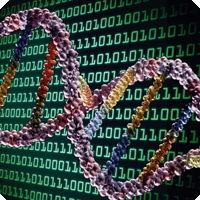Research Focus |
|
实用、高容量、易维护的DNA存储方法 2013-02-05 16:12:24 浏览次数:7874 | |
| 实用、高容量、易维护的DNA存储方法 来源:仪方生物 数字产品、传播和保存已经彻底革新了我们的获取和利用信息的方式,但是同时也增加了复杂性,需要跟积极地维护数字媒体。这个挑战将大家的兴趣集中在有吸引力的DNA这一信息存储介质,因为他的高密度编码、长时保存、易于获取、良好的信息承载记录。以往的DNA编码存储的信息量很少或不适于向上兼容、没有强健的纠错能力并且缺少大量信息的高效校验。研究者描述一个大规模可靠储存更多信息的方法,他们编码一个总计739kb的硬盘储存的电脑文件,估计Shannon信息为5.2*10(6)位的DNA编码,合成这个DNA,测序,然后重新构建这个文件具有100%的准确率。理论分析显示这个基于DNA纯粹的方式超越了目前的全球信息总量并且提供了一个大规模、长时、不经常访问的数据获取的技术。实际上,目前的科技趋势是减少DNA合成费用在一个十年之内低于50年存储的费用的水平上。 Towards practical, high-capacity, low-maintenance information storage in synthesized DNA. Nature. 2013 Jan 23. doi: 10.1038/nature11875. Goldman N, Bertone P, Chen S, Dessimoz C, Leproust EM, Sipos B, Birney E. Source: European Bioinformatics Institute, Wellcome Trust Genome Campus, Hinxton CB10 1SD, UK. Digital production, transmission and storage have revolutionized how we access and use information but have also made archiving an increasingly complex task that requires active, continuing maintenance of digital media. This challenge has focused some interest on DNA as an attractive target for information storage because of its capacity for high-density information encoding, longevity under easily achieved conditions and proven track record as an information bearer. Previous DNA-based information storage approaches have encoded only trivial amounts of information or were not amenable to scaling-up, and used no robust error-correction and lacked examination of their cost-efficiency for large-scale information archival. Here we describe a scalable method that can reliably store more information than has been handled before. We encoded computer files totalling 739 kilobytes of hard-disk storage and with an estimated Shannon information of 5.2 × 10(6) bits into a DNA code, synthesized this DNA, sequenced it and reconstructed the original files with 100% accuracy. Theoretical analysis indicates that our DNA-based storage scheme could be scaled far beyond current global information volumes and offers a realistic technology for large-scale, long-term and infrequently accessed digital archiving. In fact, current trends in technological advances are reducing DNA synthesis costs at a pace that should make our scheme cost-effective for sub-50-year archiving within a decade. |
